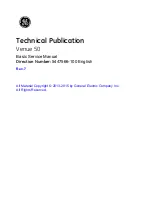
13
EATON
IB528001EN
Installation instructions
Installation Instructions - Arena Series
b. Using tape measures, set paper plates on the floor along an x/y grid every 20 feet. Write the location coordinates in
large numbers on the back of each plate and set it face down on the floor so the numbers are up.
i.
For example, a plate 20 feet in the positive x direction and 40 feet in the negative y direction would have “20,-
40” written on it.
ii. As a second option, you can also use the individual aiming coordinates from the schedules to lay a plate at each
aiming location rather than in a grid format.
c. Other type of marking items could be used, but keep in mind that lightweight items such as blank pieces of paper
could easily move and disrupt proper aiming.
d. When you are finished laying out the grid, the numbers should be visible from the luminaire locations.
e. For each luminaire, determine the correct aiming point by using the grid plates as visual guides. Aim the luminaire.
f. Repeat the procedure for each luminaire.
3. Other techniques
a. As long as the lights are aimed at the correct points according to the project design as shown in the Installation
Drawings, the installer may use any combination of these suggestions or other aiming techniques to facilitate the
aiming process.
Final aiming:
Aiming information is exported from computer lighting simulation software. Since on site conditions may vary from the
computer models, final aiming is usually required to fully achieve desired lighting specifications. Final aiming means deviating
from designed aiming parameters to produce the best outcome on the playing surface. Typically, final aiming only requires
slight adjustments.
1. Verify that all lights are correctly aimed according to the photometric or installation drawings.
2. Measure light levels on the playing surface using a calibrated light meter. Unless otherwise noted, foot-candle readings
are taken at 3’ above ground, holding the meter out at arm’s length as much as possible, thereby reducing the effect of
the shadow from your body.
otee:
N
Take horizontal readings by holding the meter face up, horizontal with the ground. Take Vertical foot-candle readings by
facing the meter at an angle toward the vertical main or vertical end point. These vary based on venue and sport, but
basically refer to the typical locations for elevated main cameras, at the center lines directly off of the side and off of
the end of the playing surface.
Refer to specific project requirements or governing league regulations for more information. For reference, the NCAA lighting
best practices website has grid layouts by sport:
http://www.ncaa.com/news/ncaa/article/2013-11-21/ncaa-best-lighting-practices
3. Review the light measurements and compare the data to project requirements or photometric drawings. If the light
measurements do not meet designed levels, final aiming is required.
otee:
N
There is no hard and fast rule on how to make final aiming adjustments as it is essentially an art form due to the
propagation and reflection properties of light. A bright spot is usually not caused by one individual luminaire but rather
the additive effect from several luminaires aimed in the same general vicinity.
4. Note the areas of the playing surface that are the brightest and darkest and determine which luminaires are aimed
toward the bright areas and which are aimed near the darkest areas.
5. Re-aim one or a few lights away from the bright areas and closer to the darker areas.
WARNING
During final re-aiming, always minimize the number and size of aiming modifications. Make just one or a few small
adjustments and then re-check light levels. Making too many significant aiming changes may result in failure to meet
specified levels or introducing unwanted results such as glare.
6. Re-measure light levels in areas where adjustments were made and compare new results to project specifications.
7. Repeat steps 5-6 as necessary to meet light level requirements.


































